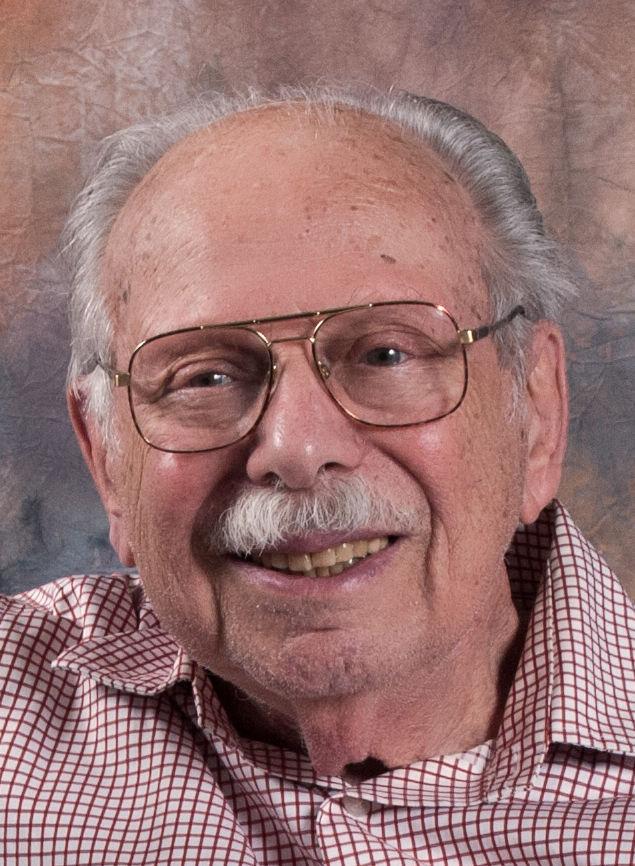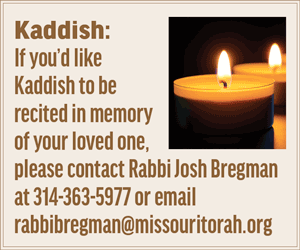Synagogue architect, WWII POW Jack Sorkin dies at 92
Published March 29, 2017
Jack Sorkin, a well-known architect who designed several Jewish congregational buildings as well as hundreds of schools in the St. Louis region and Missouri, died Wednesday, March 22, after a long period of declining health. A decorated World War II veteran and POW, he was 92 and a lifetime resident of the St. Louis area.
Mr. Sorkin was born in St. Louis on June 11, 1924, the first child of Nathan Sorkin, a cabinetmaker, and Pearl Turken, both of whom emigrated as children from what is now Belarus to the United States and frequently spoke Yiddish, in which Jack became fluent.
Mr. Sorkin’s paternal grandfather was Cheder Melamed, and Jack attended his Hebrew school. Jack grew up in St. Louis, except when Nathan moved the family to New York during the Depression to look for work. After three years, the family returned to St. Louis.
The family lived in a duplex on the “Meet Me in St. Louis” block, the 5100 block of Kensington Avenue.
A 1941 graduate of Soldan High School, Mr. Sorkin earned a degree in architecture from Washington University. In 1942, he enlisted in the military and became a navigator with the Army Air Force during World War II. He served in the 92nd Bomb Group, known as Fame’s Favored Few — the title of a 1996 book that chronicled the unit’s WWII exploits and provides an overview of Mr. Sorkin’s military service:
“While serving as navigator on a raid over Cottbus, Germany, southeast of Berlin, he was shot down on May 29, 1944, just before his 20th birthday. After jail at an airfield, he was taken by train and subway through Berlin to an interrogation center in Frankfurt. He spent 11 months as a POW in two different locations, being forced to move from one stalag to another by foot and train as the Allies advanced on the Germans.”
St. Louis media followed Mr. Sorkin’s story after he went missing in action and became a POW.
Mr. Sorkin was liberated April 29, 1945, by the Third Army under Gen. George S. Patton. He was discharged in November 1945 with the rank of 2nd lieutenant and was awarded the Air Medal with Cluster, Purple Heart, ETO (European Theater of Operations) and POW medals.
Upon returning from the war in 1945, Mr. Sorkin met a woman whose family had moved in upstairs while he was away. He married Florine Hope Roth in November of that year. They were married for 65 years. She died in 2011.
After receiving his degree in architecture, Mr. Sorkin worked for some well-known firms, including LeBeaume, Abbitt and Unland; and Russell Mullgardt and Schwartz. In 1953, he joined the firm of Charles W. Lorenz, which became Sorkin-Ginsberg and Associates.
Mr. Sorkin’s firm designed the Traditional Congregation and Tpheris Israel Chevra Kadisha synagogues, both on Ladue Road, and the Gudder Education Building for United Hebrew Congregation on Conway Road.
Mr. Sorkin specialized in designing schools. His firm did work for dozens of school districts through the population boom decades of the 1950s, ’60s, ’70s and later, including Berkeley, Ferguson-Florissant, Lindbergh, Parkway, Rockwood, Eureka, St. Charles, Francis Howell, Fort Zumwalt, Washington, New Haven, Salem, Osage Beach, Camdenton and many others around the state.
The firm also designed the popular visitor centers at Powder Valley Nature Center and Ha Ha Tonka State Park.
Mr. Sorkin was active in professional, civic and Jewish activities. He served as president of the St. Louis chapter of the Construction Specifications Institute and as an officer of the American Institute of Architects local chapter. He was chairman of the Clayton Parks and Recreation Commission. He was a member and former board member of United Hebrew Congregation, and was active in the Jewish War Veterans, Missouri Department.
Mr. Sorkin was predeceased by his brother Lou Sorkin (Mary, Jane Ranshaw) and sister Sylvia Resnick (Jess). Survivors include children, Richard Sorkin (Kathy); Cheryl Sorkin Shelton (David) and Steve Sorkin (Jeane Vogel), all of St. Louis; five grandchildren; and three great-grandchildren.
Funeral services were held at Beth Hamedrosh Hagodol Cemetery, with Rabbi Howard Kaplansky officiating.
Contributions in Mr. Sorkin’s memory may be given to charity of the donor’s choice.















